Contents
It may seem that after the harvest in the garden there is nothing left to do until next spring. The trees shed their leaves and hibernate, the beds in the garden have been cleared. Winter is coming – the time of rest and maintenance of the garden is not required. But caring for fruit trees in the fall takes all the gardener’s time until winter. Gardening is not necessary every day, but all three months before the onset of winter.
How to care for fruit trees in autumn
Autumn care for fruit trees begins almost in August. The plant must have time to prepare for wintering, and for this it needs to be harvested. While the fruits are hanging on the tree, the processes of preparing for winter do not start. If the climate allows, the process of caring for fruit crops can be distributed monthly. If the garden is large, then this distribution will be optimal.

September
Procedures to be done in September:
- harvest;
- remove trapping belts from the trunks;
- collect all the carrion from the ground;
- carry out sanitary pruning;
- shed near-stem circles with a solution of potassium permanganate;
- treat tree trunks with copper chloride.
By autumn, the fruits remain only on apple and pear trees, but it is advisable to remove them before September 10. Late-ripening varieties of apples can be removed by the end of the month, then all care procedures will have to be carried out a little later. The time between garden work will need to be compacted, but in the northern regions it is often necessary to do everything almost simultaneously in order to finish caring for fruit crops by mid-October.

Hunting belts against ants and other non-flying pests are removed, as the insects are already beginning to hibernate, and the protection will interfere with the care of tree trunks. The scavenger is picked up from the ground. Mold spores from rotting fruit can get on the tree and cause fruit rot the following year.
During the period when the trees are preparing for wintering, but the foliage has not yet fallen, drying and diseased branches are clearly visible. After a general “tidying up” of the garden, sanitary pruning is done. There are two opposite positions regarding the autumn formative pruning. Some gardeners believe that everything should be postponed until spring. Others are convinced that autumn is the best time to form a crown and remove excess shoots. But forming pruning and thinning of the crown is best done after leaf fall, when all the shoots are clearly visible and you do not have to wade through the foliage.

Disease control
Two subsequent care operations serve this purpose. An easy way to reduce the likelihood of gum disease in plums, cherries, cherries and apricots is to shed the near-stem circles of these fruit trees in autumn with a solution of potassium permanganate. For each tree you need to spend 3 buckets of medium strength mortar.
The treatment of trunks from fungal diseases in September is carried out using copper oxychloride. In stores, it can be sold under different brand names. If the month is warm, insects can still be awake at this time, and the foliage will close the branches from the chemical, so only the trunks of fruit trees are processed in September.
It is too early to clean off the exfoliated bark in September. In addition, it does not help if the fruit tree is infected with a fungus. Copper chloride is diluted according to the instructions and the trunks are sprayed, paying special attention to suspicious cracks. On this care for fruit trees in September can be considered complete.
October
The month of the main stage for caring for fruit trees in autumn in preparation for winter. This month is
- leaf cleaning;
- digging the earth;
- fertilizing fruit trees;
- spraying from pests;
- pre-winter watering;
- provide protection against sunburn.
After the leaves fall, they are raked into a heap and burned. In most cases, the foliage of fruit crops is infected with pathogenic organisms and should not be left on the compost.
Digging the soil will improve moisture permeability and allow frost to destroy pests burrowing into the ground. They dig up the entire garden or just near-stem circles of fruit trees.
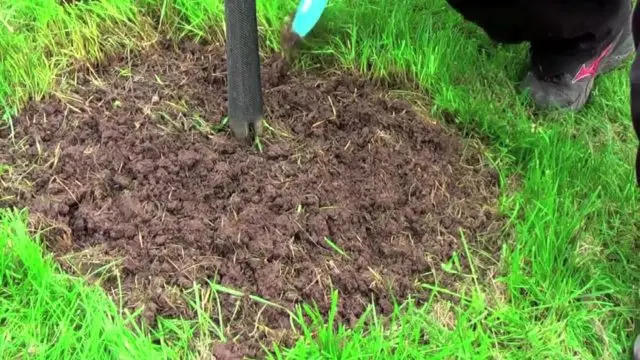
Top dressing with fertilizers will allow the trees to “reimburse” the cost of producing fruits. After leaf fall, it is better to once again treat trees from pests and fungi. At this time, it is possible to process not only trunks, but also branches. The main treatment at this time is carried out against pests that have climbed into the shelter. But since the branches from the fungus were not processed, the fungus is also destroyed at the same time.
Pre-winter watering is done before the onset of cold weather, around the end of October. But you should be guided by the climate and weather forecast. If watering was insufficient or the cold snap came suddenly, it is advisable to treat the trees with lime to prevent sunburn.
November
In late October and early November, heat-loving fruit trees are already being insulated for the winter and protected from rodents, if required. Additionally, trees protect against sunburn.
Autumn watering fruit trees
In parallel with the preparation for winter, fruit trees must be watered. Sometimes it may seem that fruit crops need watering only once before wintering. In fact, everything is not so.
A fruit tree in a productive period needs a lot of moisture, which is why the roots work in pump mode. Watering fruit trees is also necessary in the summer, while fruits ripen on them. In autumn, after harvesting, it is necessary to restore the water balance of the plant itself. If it rained almost every day in summer, you don’t have to worry that the tree lacks moisture. In all other cases, watering will be necessary.
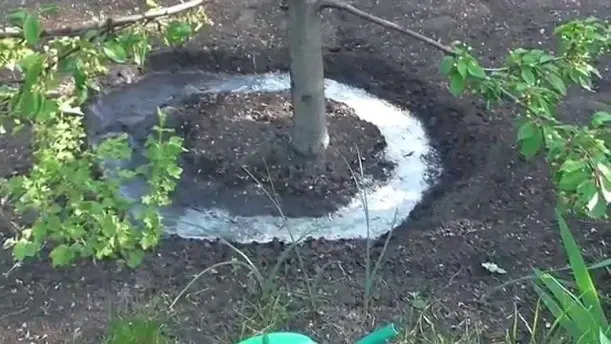
Should fruit trees be watered in autumn?
In the people there is an expression “freezing”. This is how clothes were dried on the street during the absence of electric dryers. The moisture in the washed clothes froze, and then slowly evaporated. Due to the fact that the humidity of the frosty air is low, the laundry dries very quickly. On rainy days in autumn, the drying process was much longer. The effect of freezing is present in the freezer if you put open food there.
Fruit trees are no exception; in frosts, moisture also evaporates from them. The lack of moisture will affect the spring. Therefore, before the cold weather, it is necessary to have time to saturate the plants with water in sufficient quantities.
Also in the fall, flower and growth buds are laid, which also require moisture for full development. The third reason for abundant pre-winter watering of fruit trees is sunburn. Most often they occur on sunny frosty days, if there was poor watering in the fall. The only case when you need to be careful with watering is high-standing groundwater.

Autumn watering dates for fruit trees
In autumn, watering fruit crops is included in the “mandatory program” for tree care. The timing and amount of water consumed depend on the weather conditions of the current year. If the year is rainy, the number of irrigations and the amount of water used are reduced. In a dry year, watering is carried out more often, and the volume of water is increased. In extreme dry summers, watering is carried out once a week. At the same time, moisture under the tree should flow for 3-4 hours. The pressure is adjusted so that the water does not pour out of the near-trunk circle, but also does not have time to be immediately absorbed. In Our Country, such a drought happens very rarely, so watering for half an hour is usually enough.
With high-quality watering, the soil under the plant should be saturated to a depth of 1,5 m. The minimum possible depth is 0,7 m. The last indicator is the figure for a region with a thin fertile layer. If the soil lies on sand, there is no point in spilling it deep. The liquid will still go into the sand.
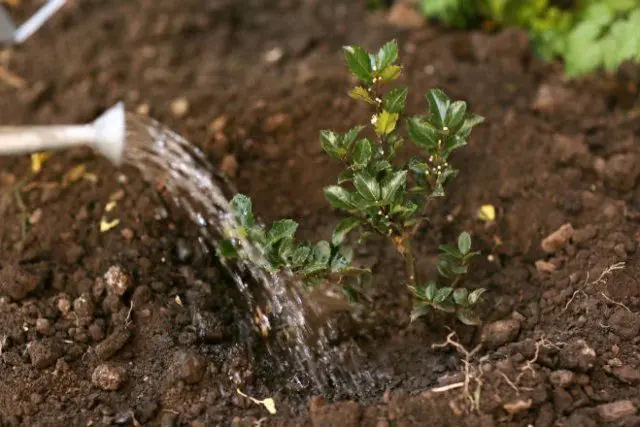
How to Determine Watering Intervals
Since the need for moisture in trees varies even in the same region and depends on the weather in a particular year, the watering intervals each time have to be determined anew. To do this, they dig a hole 0,6 m deep in the middle of the garden and take a handful of earth from its bottom. If the soil easily forms into a hard lump, watering is not required. If the soil particles do not stick together and the earth crumbles in the hands, the garden needs watering.
There is a more accurate method for determining the need for irrigation. A clod of earth taken from the pit is placed on a newspaper or paper napkin:
- the lump left a wet trail – watering is not needed;
- the lump is wet and dense, but left no trace – you can irrigate by reducing the volume of water by ⅓;
- the earth is dry and crumbling – full watering is necessary.
Clay soil does not pass water well and in this case it is necessary to ensure that excess moisture does not form in the soil. It displaces oxygen from the ground, and the roots can rot.
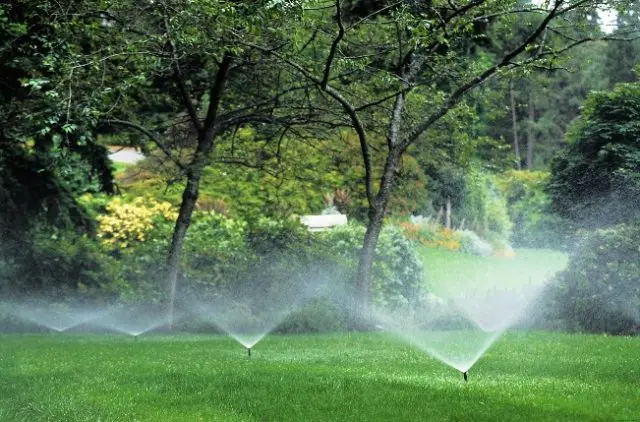
Irrigation rates per plant
When watering, take into account the quality of the soil. If the drainage is poor, the soil is soaked no more than 1 m. The type of wood in this case does not matter. When watering, they are guided by age.
It is better to water less often, but more abundantly. A young tree requires about 40 liters of water. Trees 10-15 years old require 40-70 hp. And old and powerful – up to 100 liters of water. This is one of the versions. Other gardeners claim that this amount of moisture is not enough for the plant and watering from a hose should last 30 minutes.
Serious droughts in Our Country are rare, and for the whole autumn, an orchard may need only one watering – pre-winter moisture recharge. The last watering of fruit trees is carried out before winter – in early November, when the soil has not yet frozen. If earlier frosts are promised, watering should be carried out before the onset of frost.

How to water fruit trees in autumn
There can be 3 ways to water trees in autumn and often they depend on the degree of slope of the site:
- hose or buckets;
- sprinkler;
- drip.
When water is supplied from a hose and a bucket, a significant amount immediately pours onto the ground. If the area is flat, the liquid remains within the boundaries of the near-stem circle.
If you dig grooves to the trunk circles on a flat area, water from a hose can be supplied to several trees at once.
With an inclined area, this method is not suitable; sprinklers are used. Spraying water allows you to evenly wet the soil, but increases the humidity of the air. This can lead to fungal diseases.
The most inefficient is drip irrigation. At first glance, it does not require much work or maintenance of the trunk circles: it is enough to expand the hoses with small holes and turn on the water supply. The hose is laid out in a circle with a diameter equal to the diameter of the crown. Theoretically, inside the circle, the soil should be saturated with moisture. In fact, with this method, the soil does not get wet to the desired depth, even if watering lasts all day.

Pre-winter watering
For greater efficiency, water-charging irrigation is done using buckets or a hose. The importance of pre-winter watering when caring for fruit crops is that it not only saturates the plant with moisture, but also prevents the soil from freezing in the cold.
Often this watering is combined with the last top dressing with fertilizers. To do this, a groove 20 cm deep is dug along the perimeter of the trunk circle, where fertilizers are poured. After that, watering is done.
The water rate is the same as usual, if the weather is favorable or slightly increased with the expectation of good wetting of the soil.
When using a hose, the rate is calculated using a 10-liter bucket: they note the time during which the bucket will be filled.
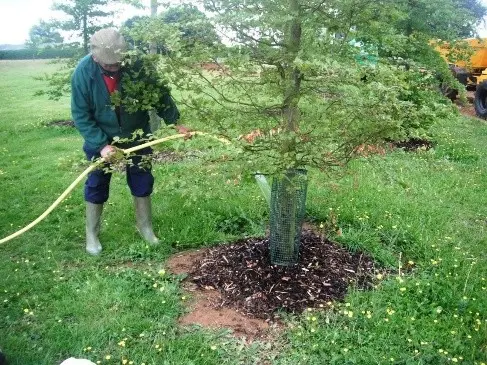
Preparing fruit trees for winter
Caring for fruit trees, in addition to watering and pest control, also includes warming for the winter, protection from sunburn and rodents, and removal of damaged areas in crops prone to gum disease.
Warming of a tree can be partial (only a stem) or complete. Completely cover the southern tree in northern latitudes. But in this case, it is necessary to form a crown so that the plant is not too tall.
Before wintering, the tree is inspected in search of damaged places from which “resin” is released. This place is cleaned, disinfected and covered with garden pitch.
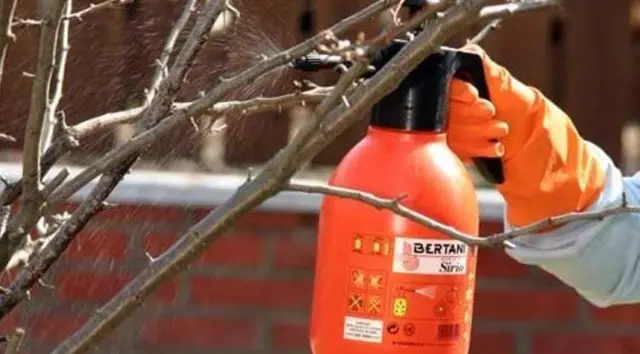
sunburn protection
Whitewash is used to protect against sunburn. In autumn care, not just a solution of lime is used, but a rather complex composition, the purpose of which is to mitigate daily temperature changes. The crust obeys the laws of physics, expanding when heated during the day and shrinking when cooled at night. Because of this, cracks appear on the bark.
The solution is prepared from a mixture of copper sulfate with lime. For old trees, this solution is prepared on the basis of a paste to get a viscous jelly. You can also add cow dung and clay to the composition. Such a whitewash will lie in a thick layer on the trunk and serve as a buffer between night and day temperatures.
For seedlings, paste is not used, since the young bark must breathe. To care for the trees, a mixture of clay, lime and cow dung is used, which are diluted with water to the density of sour cream.
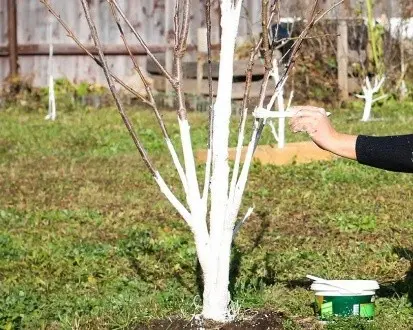
Protection against rodents
When caring for fruit trees in the fall, you can combine sunburn protection with rodent treatment. To do this, it is enough to add carbolic acid to the whitewash solution.
More often, mechanical methods of protection are used. Already with the onset of frost, tree trunks are wrapped with burlap with roofing material or spruce paws are tied to the trunks with needles down.
When using roofing felt, burlap should be laid between it and the trunk so that the trunk does not sag. Protection against rodents is made close to the ground and sprinkled with soil, as mice can crawl into very small cracks. Young trees require such care, as rodents prefer soft young bark. Old trees are not interesting to them.
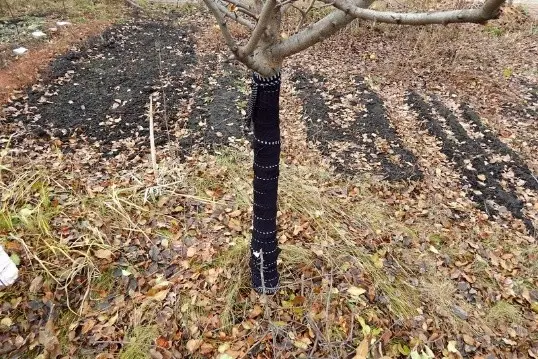
Conclusion
Caring for fruit trees in the fall is a necessary step in shaping the future harvest. Neglect of autumn care can result in freezing of trees in the cold season or in a spring outbreak of fungal diseases.









